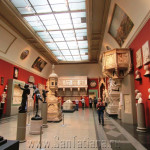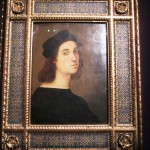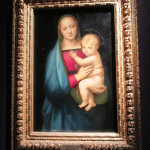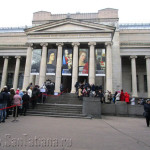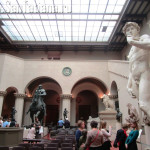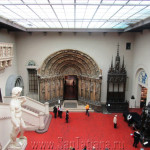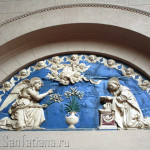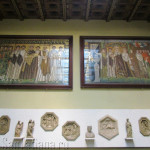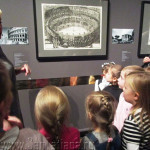by Tatiana Yugay
When being postgraduate students at the Russian Academy of Sciences, we used to spend lots of time in the Pushkin State Museum of Fine Arts. The fact is that our academic Institute of Economics (Volkhonka St., 14) was situated next door to the Museum (Volkhonka, 12). Our favorite place was the Italian Courtyard, a magnificent atrium with full-size copies of Renaissance artifacts dominated by the statue of Michelangelo’s David. In fact, the Courtyard houses not only copies of Italian masterpieces but French, German and Dutch ones. The earliest work in this Courtyard is the famous “Golden Gate” – a cast of the portal of the Freiberg cathedral (early 13th century) built in the Romanesque style.
In fact, originally it was called the “Christian Courtyard” since all the exhibits belonged to the artistic tradition originating from the Christian religious and philosophical world-outlook. Later this name was replaced by the “Italian Courtyard”. I think that the new name is more suitable because the Court’s architectural design is a replica of inner courtyards of famous Italian palaces. The idea was inspired by the courtyard of Bargello Palace in Florence; the columns and the staircase were copied from this palace. The balcony was “borrowed” from the Palazzo della Cancellaria (Palace of the Chancellery) in Rome designed by Bramante. Since both palaces represent the best examples of the Renaissance architecture, the Italian courtyard has a rather harmonious look. The Italian Courtyard serves as a stunning introduction to the Department of Medieval Sculpture and Italian Renaissance.
In my postgraduate years, I had never been to Italy and my first introduction to the art of the Italian High Renaissance happened there. When many years later, I visited the Piazza della Signoria, I was happy to see the David near the main entrance of the Palazzo Vecchio and greeted him as an old friend. Since then I’ve been traveling a lot about Italy and often meet in Italian museums the originals which I’ve known in copies. However, the most remarkable thing is that every time when I return to the Gallery, I “discover” still “new” copies of masterpieces which I’d just seen in Italy! Thus, after admiring a stunning portal by Andrea della Robbia in the Palazzo Ducale in Urbino, I “found” many copies of the della Robbia works in the Gallery.
After visiting Ravenna and falling in love with its Byzantine mosaics, I was astonished to see huge copies of mosaics from the Basilica of San Apollinare Nuovo and the Basilica of San Vitale.
After being in Padua, I suddenly noticed in the Courtyard the statue of condottiero Gattamelata which stood on guard near the Basilica of St. Anthony’s. Finally, when I came to the Gallery this autumn, I was literally struck to see the beautiful sarcophagus of Illaria del Carretto by Jacopo della Quercia which I’ve just observed in Lucca’s Cathedral of St. Martin a month before. I spent nearly half an hour admiring the Sleeping Beauty and taking photos and was very sorry that I won’t see her again. But I’ve met her a month later in Moscow!
As a matter of fact, namely the collection of antique casts was the starting point for the creation of the Museum. At the very beginning, there was the Moscow University’s “Cabinet” (Museum) of Fine Arts and Antiquities, which included Greek vases, a numismatic collection, a number of casts taken from Classical sculptures and a small library. Professor Ivan Tsvetaev (1847-1913) from the Department for the theory and history of art at Moscow University was in charge of the Cabinet. He systematically and gradually enriched the collection turning it into a Museum of Fine Arts for students and the general public. Finally, the collection had become so grand and important that it was decided to establish a Museum of Fine Arts and to construct an appropriate building in the center of Moscow.
At the end of 1896, the terms and conditions for the competition to design a building for a museum of fine arts were published. Professor Tsvetaev, when drawing up the terms and conditions for the architectural competition, had insisted that the projects submitted by contestors should be in the Classical or the Renaissance style. A young but already well-known Moscow architect Roman Klein (1858-1929) was selected out of seven contesters by the University board. The building was erected in accordance with the then latest requirements of building technology and museum design. It had the appearance of a Classical temple on a high podium with an Ionic colonnade along its façade. Its glass roof ensured that there was sufficient daylight in the first-floor galleries and the two atrium-courtyards.
The special Committee for the Establishment of the Alexander III Museum of Fine Arts started to function in 1898. Ivan Tsvetaev had become the Secretary of the Committee and its actual organizer. Grand Duke Sergei Alexandrovich (1857-1905) chaired the Committee from the moment of its inauguration until his assassination in February 1905. That same year, thanks to the efforts of the Grand Duke, 200,000 roubles were invested by the State Treasury into the construction of the museum.
Fortunately, the Museum from the very beginning enjoyed generous donations from Russian art patrons. The Deputy Chairman of the Committee, Yuri Nechaev-Maltsov (1834-1913), a leading industrialist and courtier financed the production and delivery from the Urals to Moscow of white frost-resistant marble for the facing of the Museum’s façade and colonnade. He also financed the granite base-platform and steps leading up to the entrance and the coloured marbles for the main staircase. In addition, Nechaev-Maltsov acquired the first original works of art and cultural artefacts from Ancient Egypt for the Museum. All in all Nechaev-Maltsov contributed two million roubles to the construction of the Museum and the assembly of its collection (two thirds of the total cost).
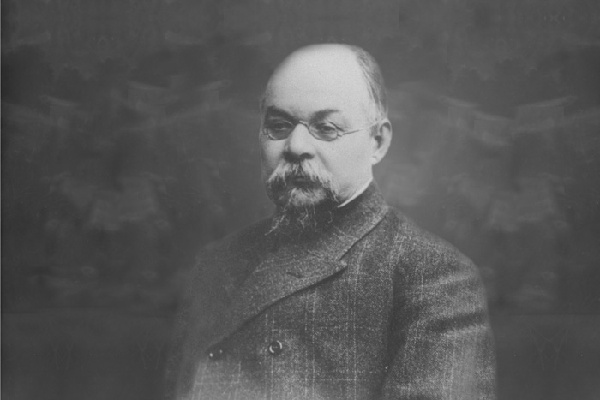
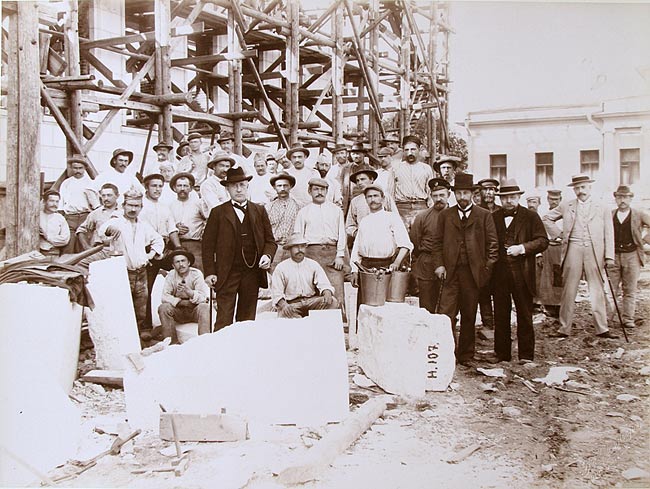
Ivan Tsvetaev was the Museum’s director from 1911 till his death in 1913. With a renewed energy, he ordered casts and other copies to be moulded directly from original art works in workshops abroad. The most representative collection of such casts and copies was that of ancient Greek and Roman art, in particular, sculpture. The collection represented the latest archaeological discoveries and scientific reconstructions of sculptures.
Shortly before the Museum opened, M.S.Shchekin donated Italian paintings and works of applied art from the 13th-15th centuries and Grand Duchess Yelizaveta Fyodorovna and Dmitri Khomyakov presented to the Museum the family collection of original Italian sculpture of the 16th-18th centuries.
The Alexander III Museum of Fine Arts opened with grand celebrations on May 31 (June 13), 1912. Emperor Nicholas II and the Dowager Empress Maria Fyodorovna attended the ceremony.
After the October revolution of 1917, the Museum was renamed after Russia’s great poet Alexander Pushkin. Fortunately, the Museum’s collection had been enriched during the Soviet period. Between 1924 and 1930, the Museum acquired a large number of pictures from nationalized Moscow estates and the Historical Museum, the Kremlin Museum and the Tretyakov Gallery, the Hermitage and other museums. Gradually the Museum had accumulated a core collection for its Picture Gallery of Western Old Masters.
In 1948, when the State Museum of New Western Art was closed and its collections were distributed between Moscow and Leningrad, the Museum acquired about 300 paintings and over 60 sculptures by West-European and American artists of the late 19th century and the first third of the 20th. Among them an important collection of French Impressionists and Post-Impressionists, which belonged to the Moscow pre-revolutionary collectors Ivan Morozov and Sergei Shchukin.
Today, the Museum collection holds around 700,000 art works from different epochs ranging from Ancient Egypt and Greece to the beginning of XXI century. Among them, a unique collection of original works of Ancient Egyptian art and cultural artefacts (over 6,000 in total) gathered by the Russian scholar and egyptologist Vladimir Golenishchev and acquired by the state in 1909-1911. My favorite highlight are the “Trojan Treasures from the excavations of Heinrich Schliemann”, or simply the Gold of Troy.
The Museum almost permanently houses arts exhibitions in collaboration with world’s largest museums. This autumn has been highlighted by the first ever exhibition of Rafael in Russia the “Raphael. Poetry of the Image” and an interesting exposition the “Piranesi. Before and after. Italy – Russia. XVIII-XXI Century”.
I visited the Museum on a gloomy and rather cold day of November. The tickets in Internet were completely booked off, so I tried my fortune waiting in line. When I arrived, I saw two long queues. Those days, Russia’s major bank Sberbank was celebrating its 175 anniversary and on this occasion the bank made a very generous gift to all art lovers. It granted free admission to many Russian museums for two months – from 1 October to 30 November. The Pushkin State Museum of Fine Arts was included in this gift list. However, the Rafael exhibition wasn’t covered by this offer.
It took me one hour to enter the museum. Since I had about half an hour before the session, I visited my favorite Italian Courtyard.
The exhibition was organized together with the Uffizi Gallery and exposed 8 paintings and 3 drawings. With a certain awe I entered a dimly lit hall. The exposition opens with the “Self Portrait” (1506) from the Uffizi Gallery. The image of young Rafael in a very simple black garment gave me a powerful charge of spirituality. When walking about the exhibition, I realized that I’ve already seen these pictures in different Italian museums. However, their concentration in one space had produced an overwhelming effect. The unique painting unknown to me was the stunning “Ecstasy of Saint Cecilia with Saints Paul, John the Evangelist, Augustine and Mary Magdalene” from the Pinacoteca of Bologna. I liked most of all a charming “Madonna del Granduca” (1505) from the Palatine Gallery.
Though I was completely emotionally exhausted, I decided to make a quick tour about the Piranesi. The exhibition appeared to be very interesting and informative. First, I saw the “Vedute di Roma” and tried to recognize landscapes of modern Rome on ancient engravings. A group of children very attentively listened a guide.
Besides, there were two series of architectural fantasy – “The first part of the architectural composition and perspective” and the “Fantastic compositions of dungeons”. In addition, there was demonstrated a French video with animated 3D projections of dungeons. Though they were very gloomy and even frightening, I could not take my eyes from them. Finally, there were exposed architectural designs of Soviet architects influenced by Piranesi.
My Italian day in the Museum of Fine Arts was very emotionally intense and interesting. Fortunately, my Italian season in Moscow is far from being over. I look forward to visiting the great exposition of paintings from the Vatican Museums which has been inaugurated last week in the Tretyakov Gallery.
Pubblicazione gratuita di libera circolazione. Gli Autori non sono soggetti a compensi per le loro opere. Se per errore qualche testo o immagine fosse pubblicato in via inappropriata chiediamo agli Autori di segnalarci il fatto e provvederemo alla sua cancellazione dal sito


